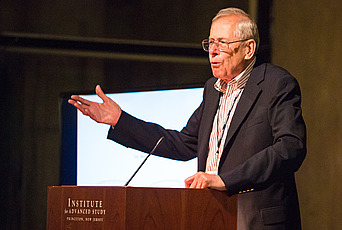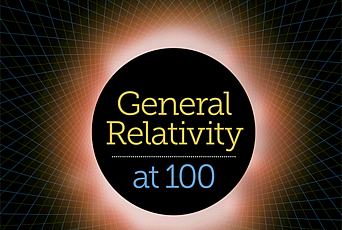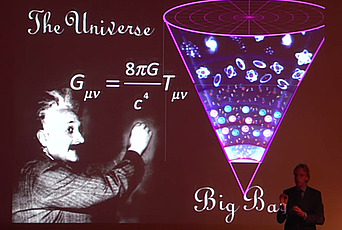A Conversation with James Peebles, 2019 Nobel Prize Laureate in Physics
James Peebles, Member (1977–78) and Visitor (1990–91, 1998–99) in the School of Natural Sciences, has been awarded the 2019 Nobel Prize in Physics (see his lecture above) for his “contributions to our understanding of the evolution of the universe and Earth’s place in the cosmos.”
The Royal Swedish Academy of Sciences—which awarded half of the prize to Peebles, and the other half to Michel Mayor and Didier Queloz “for the discovery of an exoplanet orbiting a solar-type star"—further cites Peebles for his insights into physical cosmology, which have “enriched the entire field of research and laid a foundation for the transformation of cosmology over the last fifty years, from speculation to science. His theoretical framework, developed since the mid-1960s, is the basis of our contemporary ideas about the universe.”
“Nobody has done more for our theoretical understanding of the origin, composition, and evolution of the universe than Jim Peebles,” said Robbert Dijkgraaf, IAS Director and Leon Levy Professor. “Building on Albert Einstein’s general theory of relativity, Jim’s work allows us to reconstruct the history of the cosmos from the earliest signal emitted just after the Big Bang.”
Peebles, who is currently the Albert Einstein Professor of Science, Emeritus, at Princeton University, served on the organizing committee for “General Relativity at 100,” a celebration of the centennial of Einstein’s general theory of relativity, organized by the Institute and Princeton University in 2015. The conference included a discussion moderated by Peebles on the seminal role of Princeton physicists, particularly John Wheeler (Member, 1937) and Bob Dicke (Member, 1970–71) and their students, in advancing an examination of general relativity.
At the time of the conference, Peebles spoke with the Institute Letter to provide some context about the resurgence of interest in Einstein’s general theory of relativity, alternatively known as a theory of gravity. The following is an edited transcript of the conversation.
IL: Could you talk about the period of time when Einstein’s theory of general relativity was not an active area of research?
JP: People were working in general relativity in the 1930s and 1940s. Howard Percy Robertson at Princeton University was doing interesting things. But it was quite low-key, and indeed by the mid ’50s, or let us say by ’58 when I arrived at Princeton as a graduate student, the usual feeling was that general relativity is an elegant theory of very limited interest. Of course, the big actors then were particle physics and quantum physics. Condensed matter was starting to heat up, but general relativity—eh, a dead end.
At about that time, a few people around the world decided that we should look more closely at gravity physics and general relativity. I think it is fair to say that the two dominant leaders were at Princeton University—John Archibald Wheeler on the theoretical side, Robert Henry Dicke on the experimental side—both beginning around 1957 or so.
I arrived at Princeton as a graduate student in 1958, when Bob Dicke was assembling a group to do experiments to test general relativity and alternative theories of gravity. I was one of Bob’s two theoretical students. It was great for me, because he was doing just the sorts of things that fascinate me. He set my career.
It became clear that there was a lot to be done in gravity physics, both theory and observation. As I said, in the 1960s, only a few people were working on both sides of gravity, theory and experiment. It was an exciting time that offered me lots of room for exploration of new ideas. But of course we couldn’t anticipate that this work would grow into the present big science.
IL: Why was general relativity not interesting before then?
JP: It was not interesting because no one thought to look, and because the technology needed to make the experimental part interesting was not available before the war. Research in World War II was enormously transformative. And a big part of that was the technology developed during the war made an enormous difference to what could be done in the laboratory.
One talks about the atomic bomb as transformative, but radar was perhaps even more so, and a lot of that development happened at the radiation laboratory based on the MIT campus, where Bob Dicke worked, inventing electronics—in particular, the Dicke radiometer. Twenty years later, we returned to the Dicke radiometer. His Gravity Research Group used it to discover and explore the properties of the cosmic microwave background radiation.
IL: What problems were you personally working on at the time?
JP: My thesis was on a test of whether the strength of the electromagnetic interaction changes with time. A measure of the electromagnetic interaction is termed the fine-structure constant. It is a constant in standard physics, but Bob Dicke was interested in whether that number changes with time.
I could find lots of data that constrain how much it could have changed. I could also make a little theory about how it might change, one that could account for all the constraints that we had, and what new measurements could be made to further constrain and test the theory. It was an exploration of a possibility. There still is lots of interest in the question, “Does this fine-structure constant evolve?”
IL: What is your sense about gravity’s place in physics?
JP: I love physics in all its manifestations, and I think of gravity as one of the parts of physics. I don’t think of it or cosmology as particularly special; the physics of materials is just as fascinating as the physics of gravity. When I was a graduate student it was said that particle physics is the queen of science, the rest engineering. A respected senior physicist said that to me. I was shocked.
Particle theory is, indeed, magnificent, but I don’t see it as the queen of physics, or that there is such a thing as a central and fundamental core of physics. There are so many aspects to physics, each fascinating, with research on each operating according to the conditions one has to live with.
Dirac wrote, approximately, that “the physical laws of chemistry are completely known.” That very well may be true in principle, but in practice, chemistry is not solved. Chemistry today uses quantum mechanics, to be sure, but it is following its own hierarchy of approximations that are quite different from the hierarchy that leads you down to the Higgs. I am sure chemistry and particles are tightly related, but I don’t know that their relation goes entirely one way, that if you understand particle physics, you can understand chemistry. And I am pretty sure that if you understand chemistry quite well, you won’t necessarily understand particle physics. When both are better understood, they might merge in some deeper level of the hierarchy of successive approximations. But that is for the future.
When we learn how the brain works, we will have a whole new hierarchy of theories that someday, somehow, may connect with particles and chemistry on some deep level. And I expect gravity physics is part of this game too, somehow.
IL: When you think about the theory of general relativity back when you began testing it and now, how has it changed for you?
JP: When I came to Princeton as a graduate student, I had no interest in gravity. Back then, there was a gravity theory, the general theory of relativity, but it had close to negligible empirical support. I first learned elements of general relativity because it was on the graduate general exams, but I thought the aspects I was exposed to were kinda Mickey Mouse. But I fell under Bob Dicke’s influence, I liked his analysis of data, and that showed me that I had better understand general relativity theory. To me, previously, it seemed empty. I much prefer theories that involve measurements, which is the case for general relativity now.
Watch videos from "General Relativity at 100," including a discussion moderated by Peebles on the seminal role of Princeton physicists in advancing an examination of general relativity, here.
It is to me more than a little startling to consider how well tested that theory has become. I am deeply impressed that Einstein’s vision of 100 years ago has survived. Of course, great challenges remain. Two challenges are to understand how to reconcile the quantum and relativity principles, and how the world operates within this theory to be discovered.
We have the more immediate and deep problems of understanding dark matter and dark energy. I am particularly fascinated by the manifestations of the properties of dark matter in the mass concentrations known as galaxies. Despite great progress in the theory of galaxy formation, there are fascinating properties of galaxies that remain poorly understood. That is in part because galaxies are complicated, but I can’t resist the thought that it may be in part because we don’t have an adequate understanding of the nature of dark matter. So a lot of my effort these days, when I’m not being a historian, is thinking about properties of galaxies and lessons they might be offering us about gravity physics and dark matter. I like this because galaxies have lots of properties that can be measured and compiled, and it seems to me to be a good time to sift through all these data—look for regularities, look for puzzles, and think about what they may teach us.
I am quite content to leave the unification of the quantum and relativity principles to others. I did write one paper on unification back when I was a post doc, and I remember Bob Dicke laughing and saying, “All right, go ahead and do that, get your Nobel Prize, and then come back and do some physics.” ––Kelly Devine Thomas, Editorial Director


